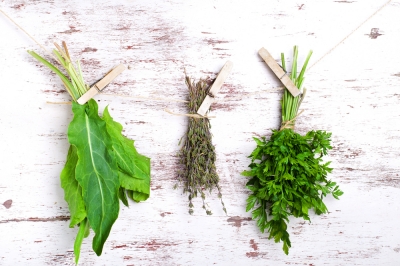Parsley has a delicate flavor that goes wonderfully with many dishes. If there are no fresh stalks, it can also score dry. If you grow it yourself, you can harvest plenty in the summer and easily convert the surplus into a dry supply.

The best fresh leaves
If you pick fresh parsley in your own garden, you should choose the morning hours for this.
- cut with the stems
- only then sort out wilted and damaged leaves
- wash parsley thoroughly
- let it dry completely
- remove coarse stems
Enjoy parsley only in moderation
If you want to air dry the parsley as a bunch, the stems should be conveniently left on for now.
Options for drying
Parsley leaves are gossamer and consequently dry quickly. There are several options for drying them right away:
- Air drying
- in the oven
- in the microwave
- in a dehydrator
Air drying parsley
The air method is quite suitable for parsley, as it does not take much time, even at low temperatures. The fastest way is in the sun, then the leaves dry within a few hours. Otherwise, parsley stems can be loosely tied into a small bunch and hung upside down to dry.
Do not tie too tightly
air must be able to circulate between leaves
rather arrange several small bundles
hang them next to each other with some distance between them
not near the stove, above possible cooking fumes
Depending on the temperature, the process can take a few days or up to two weeks. If the parsley crumbles when rubbed, it is sufficiently dry.
Dry in the oven
On long hanging bundles can accumulate dust over time, in the oven it has no chance. For this purpose, this method also provides the finished result within a day.
- lay out a tray with baking paper.
- spread the parsley on it in a single layer. 3.
- put the baking tray on the middle shelf. 4.
Set the oven to the lowest temperature. 5. - Leave the parsley in the oven until it is completely dry. This can take anywhere from 2 to 4 hours. To be safe, do the crumble test.
Quick drying in the microwave
Drying in the microwave is a bit tricky, because the whole drying process is done in a rush and so can quickly miss its end. The thin parsley leaves in particular can burn quickly. Finding the right setting is also a matter of experience and testing.
- spread a layer of parsley on a paper plate
- dry for about one minute on the lowest setting
- if necessary, increase the time a little
Tips
Stay close by so you can intervene quickly if the process needs to be interrupted. For example, if the parsley begins to “smoke” or darken in color.
Drying gently in the dehydrator
For the parsley alone, its purchase is not worthwhile. But if you already have such a device at home, you can use it wonderfully for drying parsley. All the important information will certainly be in the manufacturer’s instructions. Of course, the parsley must enter it perfectly clean and dry.
Storage and shelf life
Dry parsley is stored in airtight containers. Old herb cans or jars are well suited, but must not give off any odor. It is welcome to be finely crumbled ready for use beforehand. Parsley will keep for several weeks in a cool, dry place. After that, it is still edible, but quickly loses flavor.
Conclusion for quick readers
- Preparation: Wash fresh, unblemished parsley and allow to dry again.
- Air dry: tie loosely into small bundles; hang upside down in the kitchen
- Sun: spread parsley out on kitchen paper; let dry in a few hours
- Oven: Spread out on baking paper; dry on lowest setting for 3-4 hours
- Microwave: spread parsley on paper plates; dry on lowest setting for about one minute
Tip: Danger of burns; watch the drying process so that you can intervene quickly if necessary.
Dehydrator: Gentle drying; observe manufacturer’s instructions
Storage: In an airtight container; cool and dry
Shelf life: several weeks; after that the aroma decreases

